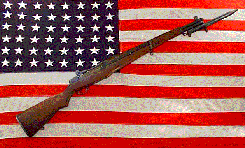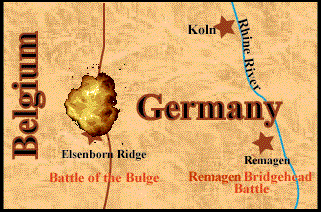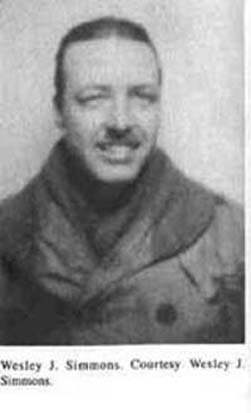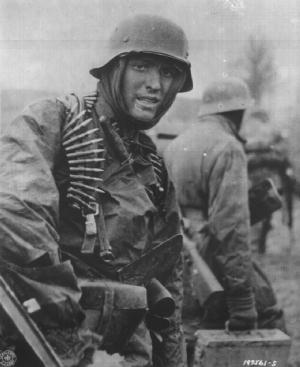

The Battle of the Bulge

It was December 16, 1944, and winter on the Belgian/German border at Elsenborn Ridge was savage. Temperatures were below zero and snowdrifts waist high. Men suffered from frozen feet and hands, pneumonia, and dysentery. Soldiers wounded a short distance away from their buddies, froze to death. There were four American divisions covering this eighty mile front; twenty of these miles were thinly held by the green recruits of the 99th Division.
At 5:30 a.m., without warning, Armageddon shattered the numbing cold. Three powerful Nazi elite armies (SS Panzer Divisions) let loose a violent storm of artillery, mortar, and rocket fire. For several hours the earth rumbled and shook from the shelling, and huge trees crashed to the ground. The eerie scream of artillery fire accentuated the screams of the wounded. The Battle of the Bulge had begun. It is regarded as one of the worst WWII battles in terms of losses to the American forces. Out numbered five to one, cut in two and partially surrounded, the 99th conducted one of the few bayonet charges in the history of modern warfare.
According to author Stephen Ambrose, holding the battle's north shoulder "did not simply delay the German advance but stopped it along its critical path - Elsenborn Ridge." The Germans were stunned at the courage and might of the young, new recruits of the 99th Division. They thought they were striking at a weak link in the American defense. Baron Hasso Von Manteuffel, Commander General of the Fifth Panzer Army, stated after the Bulge: "We failed because our right flank, near Monschau (north shoulder), ran its head against the wall." John Eisenhower wrote, "The action of the 2nd and 99th Divisions on the north shoulder could well be considered the most decisive battle of the Ardennes campaign."

Arlinghaus had just finished training at Camp Wheeler, Georgia, and was sent to Camp Blanding, Florida, as a communications instructor. He was made a corporal, promoted to sergeant, and packed tightly into a boxcar headed for the Battle of the Bulge. The boxcar was "standing room only" and the only stop during the three-day ride through France to Belgium was for K rations. The car had no bathroom facilities and men relieved themselves by hanging out the boxcar door.
Around December 28th or 29th, Arlinghaus reported to Captain Simmons, a dark haired man with a neatly trimmed mustache, whose office was in an abandoned pillbox. He thought the Captain had a confident, intelligent aura and liked him immediately. Arlinghaus told him he was a "message center chief." Captain Simmons responded "you're in the infantry now" and asked if he was qualified to use an M-1 rifle. "Yes sir, sharpshooter, sir" he replied. During late December and all of January, the 394th regiment lived in deep foxholes that had a roof partially covered with logs and shelter halves. They had tin cans filled with dirt and gasoline that blackened their faces and turned their saliva gray. Shells exploded periodically but were muffled by the two-foot snow and didn't cause much harm. The German army had already taken their beating and were in the process of pulling back. Buzzbombs (self-propelled V-1 rockets) emitted an orange flame and a putt-putt sound as they flew overhead to an unknown destination. There were so many buzzbombs that historians called the area around Elsenborn Ridge "Buzzbomb Alley."
All the men were freezing, hungry and filthy. They had no gloves and the combat boots were useless in keeping out the numbing cold. Trench foot (a painful foot disorder resembling frostbite that sometimes necessitated foot amputation) was epidemic. Only a condition such as this or a wound held out the promise of medical leave and safety.
Arlinghaus was given the "cold-shoulder" by the men who fought during the worst part of this battle (December 16th, 17th, and 18th). These young recruits saw their friends ruthlessly slaughtered. Their grief enraged and fueled them. They were angry that Arlinghaus was a sergeant and they were not. Their lieutenant promised them positions such as squad leaders and drill sergeants, and they felt robbed of these opportunities. After weeks of putting up with their comments, Arlinghaus volunteered to give up his sergeant status and become a private. The animosity became so great that a Lieutenant asked if he'd like to be transferred to another section. Arlinghaus said no, he'd stay on. Later, he wondered if he had made a mistake. Perhaps if he agreed to be re-assigned, he'd be out of the infantry and into communications where he belonged.
Company K remained at Elsenborn Ridge until February 1,1945. Upon leaving Elsenborn, the unit obtained gloves and insulated shoe packs that did a stand-up job in warming their feet. The sensation of warm hands and feet caused a euphoria that was short lived--several men were wounded by "Bouncing Bettys" (mines that when triggered jumped up and exploded) straining everyone's nerves to the breaking point. Suddenly, a violent crack-crack sound cut through the icy air and left two men dead on the frozen Ardennes forest floor. As the men ran for cover, a fire fight ensued that left several more men wounded. Suddenly a heavily accented voice yelled "Comrade! Comrade!" A German soldier gingerly crept into the clearing waving a stick with a white rag tied to it. The newly appointed sergeant ordered his men to shoot. Arlinghaus told them that if they followed this order, the battle could never end and eventually they'd all be killed. "I'm willing to quit if they are," he told the men. The soldiers chose not to shoot. Ten or fifteen more Germans stepped into the clearing one at a time and were taken as POWs.
(Historical Note: The Malmedy Massacre occurred on December 17th. The Germans had taken 140 Americans prisoner at Baugnez, not far from Elsenborn Ridge. A German Colonel, Colonel Peiper, ordered his unit to execute 86 of these American prisoners while on a road headed for Malmedy. Forty-three soldiers survived to tell the story. This event may have caused the new sergeant's "take no prisoners" attitude.)
 |
Courtesy of A. Holbrook |
The awesome twenty-mile deep German fortification known as the Siegfried Line lay in front of them. Arlinghaus read about the defense system while still in high school. The pillboxes are expertly camouflaged rooms sporting four-foot thick concrete walls built to look like softly rolling hills. The rooms are sometimes monstrous and connect to other areas that provide alternate escape routes. The structure is equipped with forty or so cots suspended from steel frames embedded into the wall; there are racks for dozens of rifles and machine guns.
Arlinghaus had scant training as a flamethrower. The easy way was to squirt gasoline into the opening and light it from a distance. That was the plan as they readied their attack at 4:00 a.m. Arlinghaus sprayed the gasoline at the top port hole and worked downward, turning the ignited pillbox into a raging furnace. After the fire died down, they found it empty except for an antique-looking gun with a ten-foot barrel. Most of the pillboxes had already been evacuated. Relieved, they moved on through the Siegfried Line noting that the painstakingly laid dragon's teeth (huge triangular concrete blocks placed in front of some of the pillboxes) were simply bulldozed by the Americans to make pathways for tank attacks. Eventually luck ran out. The next pillbox was occupied but the encounter mercifully brief. Two shots were directed at the opening and immediately the Germans surrendered. One of the two bullets fired had killed an SS officer. Once the officer is shot, the German soldiers can surrender. While the officer is alive, he requires that they fight "to the last man." The rumor among many GIs was that the German soldiers shoot the SS officer so that they can surrender.
 |
Courtesy of J Gordon |
During the first week of February, winter slowly began its own surrender in the Ardennes forest. The main road was a quagmire, while fields still clung stubbornly to their two-foot snow cover. Arlinghaus' platoon had just captured a pill box that contained a usable telephone line. He overheard the Lieutenant's phone conversation: "We've got new men here, we can't do that." Apparently they could and would because seconds later he said curtly "Arlinghaus, we need to interrogate a German soldier." Without looking in any particular direction, but nonchalantly waving an arm to indicate one, he said "the German front is that way." Although Arlinghaus smartly saluted the Lieutenant and replied "yes sir!" he had no intention of seriously looking for a German soldier. His plan was to take a walk and return empty handed. Another Private was ordered to go with him. Arlinghaus and his buddy trudged off, walking brazenly toward the German front lines through mine-covered fields. He silently cursed the military for being so tight when it came to life's necessities. A compass cost $7.50, but the army coveted them like gold. To make matters worse, dark clouds were gathering, fortelling the coming of nightfall. Identifying with the characters in the fairytale Hansel and Gretel, he decided to rely on their foot prints rather than bread crumbs to guide them back to headquarters. After walking for about a mile and a half, Arlinghaus and his buddy were stunned to see a pink-cheeked German soldier sleeping under a tree with his rifle laying across his knees. Arlinghaus grabbed the rifle, tossed it into the snow, and ordered the German to walk ahead.
Darkness descended quickly and felt like an oppressive weight on his shoulders. By now, the night was so black that the German could have dashed off five feet into the void and it would have been impossible to re-capture him. To prevent this, Arlinghaus grabbed him by the coat collar and continued the march. Their good luck quickly turned bad when he and his buddy noticed that their tracks had been obliterated by a battalion of American or German soldiers who had just recently passed along the top of a ridge. Arlinghaus's usual good sense of direction failed him as they searched futilely for their tracks. There was nothing to stop them from walking straight into the German lines or being blown to bits by a buried mine. They walked along in silence so that careless chatter would not find its way to the German army's ears. As Arlinghaus held tight to his prisoner's collar, an icy forboding gripped his own.
Suddenly, a voice yelled "halt!" and demanded the password. Arlinghaus gave it quickly and with enormous relief and gusto. At that moment, hot with embarrassment, he sheepishly yanked the German helmet off his head; he had foolishly taken it from the prisoner and forgot he was wearing it. He silently admonished himself for doing such a stupid thing. Wearing the German's helmet was a sure fire way of getting himself shot! Arlinghaus tried to re-gain his dignity while the 106th Division Lieutenant gave them directions back to the 99th lines. Several soldiers gathered around wanting to shoot the prisoner. Arlinghaus declined saying he and his buddy had worked too hard to find him.
As they slogged on down the main road, signs everywhere stated "Danger! Mines!" The gooey mud was almost up to their knees and sucked at their feet like quicksand. Arlinghaus's buddy lost a boot and he fell forward trying to find it. The German prisoner thought this was hilarious; Arlinghaus gave him a healthy shove that sent him sprawling face first into the sticky mess. He wasn't laughing now; maybe if frightened, he'd prove useful when interrogated back at headquarters. Upon arriving at the 99th lines, Arlinghaus was rewarded with K rations, a blanket, and a cot set up in a tent with two other soldiers. He thought the K rations were delicious; to sleep on a cot in a warm tent instead of a hole was bliss. The next morning the Colonel informed him that "the kid" was eighteen years old and quite smart. He had given them a lot of valuable information. The Colonel cautioned him to search prisoners in the future. A large trench knife was hidden inside the soldier's coat. Arlinghaus thought how easy it would have been for the prisoner to stab him in the chest as they walked along in the black night.